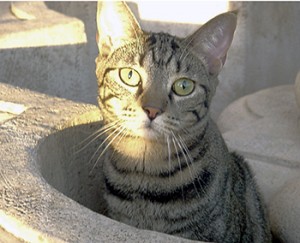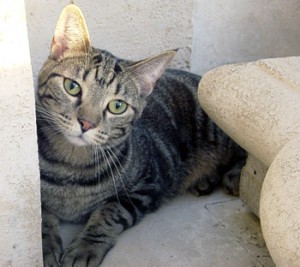6 Conversion Strategies Learned from My Cat
Note: this article will not give you the top 10 ways to grow your business with Twitter or the 50 most important ways to use Facebook to funnel traffic to your site. There will be no talk of sales funnels, conversion paths, A/B testing or the recommended size and color for buttons that will induce the most clicks. This is just a simple way to understand conversion strategy from one of the most intelligent of all mammals—the domestic house cat.
Cats invented permission-based marketing
One Saturday, bleary eyed from catching up on the latest and greatest online marketing thought leadership, I took a break to play with my new kitten, Meiko. As she decided what she would and would not allow me to do in my attempts to engage her, it hit me: cats really are the originators of permission-based marketing.

Meiko the Muse
If you know cats, then you know that, unlike dogs, cats do not greet newcomers with gusto. Usually they will not accept your advances until they have decided to let you into their circle of influence. At first, you may even have to act like you’re not interested in them. Your disinterest will gain their attention. They may then approach to sniff your finger or nuzzle their head against your hand. Those acts are their way of saying, “You now have permission to interact with me, but don’t expect me to sit in your lap or heaven forbid, lick you.” (By the way, consider a cat jumping into your lap a feline’s supreme sign of engagement; but it’s not one you should expect very often from any cat, let alone one you have just met.)
Lesson 1: Give potential customers a chance to warm up to you.
Like new cats, potential customers need time to warm up to you. You can’t pounce on them with your latest offer and expect them to simply take you up on it. With some you will have to wait to get a sense of how and when they are ready for you to show them some love. Asking them to immediately contact you when they don’t even know you is like rushing up to a strange cat and asking them to climb into your lap. Not going to happen.
Cats, like customers, just want to be understood
The old joke is dogs have owners; cats have servants. Who are you but just another human they expect to cater to their every whim. For them to accept an unsolicited offer, you would have to be doling out exactly the type of treat or toy they like, at that moment. That means you would have to know exactly what to offer and when. How many times are you likely to have that inside knowledge right off the bat? Not many. This is precisely why you must start with Lesson 1 above and let the cat (or customer) warm up to you.
Once that happens, you score an engagement opportunity. Use this opportunity to your advantage and take the time to learn the signs. Cats, like your customers, need to be figured out. What does that look mean, that meow, that tail movement. Where do they like to be scratched, how do they like to be talked to, can you pick them up? Do they like a good belly rub? Do they take their catnip in the form of powder, pellet, sticks and buds or fresh off the plant?

Shameless Cat Cuteness
Lesson 2: Listen for engagement opportunities and use the opportunity to get to know your potential customer
Potential customers, like cats, expect you to cater to them. They have lots of choices and limited time. Therefore you have to find ways to get them to feel you are listening to their needs, their desires and the opportunities they are granting to you for engagement with them.
Take the time to get to know why people are visiting your website or your web eco-sphere (website + email lists + Twitter + Facebook, etc). What content are they consuming and when? There are more “listening” tools than ever before. Pay attention to WHAT people are tweeting, not just how many followers or mentions you get and then reach out with a tweet to a particular follower with an answer, comment, encouragement, whatever.
Are particular types of content getting more attention on your blog or Facebook page than others? Then do more of that so that your audience starts to see you as a source of something they want. Ever ask your visitor to take a short (and the key here is “short”) survey or answer a poll question? That’s a low investment engagement for a visitor plus you learn something about them. All of these methods will start to let you see the problems your potential clients are trying to solve.
Customers, like cats, need their space
Little by little as you get to know the cat, you begin to understand what she really means. And it’s not always what you think. That slow but constant swish of the tail…not a sign she is particularly open to engagement. Quite the contrary—she really desires to be left alone or at least to have very limited intrusion on her personal space. (In human terms: You might want to hold off on sending that month long email drip campaign or “following” up with a phone call if your potential customer seems disinterested or unresponsive.)
Once the cat senses your interest in her desires, trust begins. Now deeper engagement opportunities can occur, allowing you to learn even more about your furry friend—perhaps enough to figure out how to get her interested in what you want her to be interested in. (At this point, if the cat should climb into your lap, that’s a qualified lead conversion.)
Lesson 3: KEEP listening and back off when necessary
Give the customer time to self-segment into a subcategory of your business and then listen to what they are telling you with those segments. Don’t know how to get your customers to self-segment? Try surveys, polls, submission forms with choices and trackable on site events such viewing a video or downloading a white paper. Some of these tactics can be used to harness a one-to-one relationship; others allow you to gain knowledge about your customers as a group.
Give away treats
Cats, like people, can be trained. They can be trained to do what you want (a/k/a a “conversion”). But often you must give them something in return. Some cats will be more finicky about their treats than others. Some may take anything that is not their daily kibble while others will only accept tidbits of fresh tuna.
Likewise there are some customers who will take anything you throw at them and some will be more picky. It doesn’t matter. Offer something. In this world where you can literally reach out and get something for free 24/7, you can’t afford not to give people something for their trouble. But little by little you learn which type of cats (or potential customers) will respond to which offers.
Lesson 4: Offer something in exchange for engagement
This “something” could be as simple as a short article on the Top 5 Ways to…(fill in the blank here with something particular to your business) or as long as a comprehensive whitepaper detailing your findings on a topic that is currently hot in your industry. Some offers can be so irresistible to people that they have no problem giving you more than just their email address. Test this tactic out to see what works for your company in your industry. When a customer is “treated” enough to good information, say in an email drip, they may respond to your next offer without any freebies in site.
Get to the sale: It’s all in what you’re meowing about
Let’s say you’re trying to sell your premium catnip blend. You’ve given out fantastic information on your blend and maybe even a few samples but conversions are still not there. It’s possible you’re not offering cats the solution they really want: an enjoyable way to make the time pass while Mom’s not home.
Don’t be fooled. Just because you tell the cat your catnip blend features the highest potency of nepetalactone doesn’t mean the cat will convert. What do they know about nepetalactone? Once you have the cat interested, sprouting off what you feel is important about your nip isn’t as important as addressing the cat’s real concern—will I get what I really want: a fun diversion that doesn’t make me grumpy later?
Lesson 5: Sometimes repeated engagement doesn’t work because you are engaging with the wrong message.
There is always the question of benefits versus features—which is best to focus on. Features are nice to know about but only if you have bought into the benefits of the product or service, right?
Out of sight but not necessarily out of mind
Let’s say you hit paydirt. You got the cat to take to your catnip. The cat has enjoyed your premium catnip, thank you very much, but she is now onto bigger and better things, like destroying the living room couch. Just because the cat is not actively engaging with you, doesn’t mean she is ignoring you or has forgotten you were there. She’s just busy. And unlike dogs, cats are not interested in pleasing you. They may, however, still be interested in what you might offer them.
Lesson 6 : Don’t think that customers aren’t paying attention to you just because the sale is over.
After the sale, you must continue to provide various ways to deliver that catnip, tips for how to enjoy it, keep it fresh, new blends to try—you get the idea. The takeaway here is that even after you make the sale, you should continue to deliver some value. We all know this but in our day-to-day dealings with clients, many of us are all too focused on attracting the cat but not maintaining the feline’s relationship.
Your customers still need you—for support, for ways to get more value out of what they have purchased, or even as a sounding board for complaints (yes, you must be there). Likewise, you still need them, if only to make sure they still like you enough to recommend you. Remember word of mouth can get you new customers. Don’t be so focused on gaining traffic and new conversions that you forget about the value of your current customers.
So instead of trying to remember all the latest thoughts, findings and manifestos about conversion strategy, just remember our feline friends and think…hey, what would I have to do become part of that cat’s circle of influence.
Note: no cats were harmed in the preparation of this post.
Update: If you like lessons from cats, check out this great post from Kim Phillips of Lucid Marketing on The 12 Most Eye Opening Marketing Lessons I Learned…from My Cat.








Carolina
January 6, 2011 at 4:25 pm
Such a clever post! Thanks Lisa for creating marketing lessons in layman terms / analogy.
lhutt
January 6, 2011 at 5:36 pm
Carolina…thanks for your kind words. I always find analogies helpful.
Sally Outlaw
January 10, 2011 at 11:22 pm
Ok – even as a DOG person I picked up some good tips 🙂 Thanks for the post!